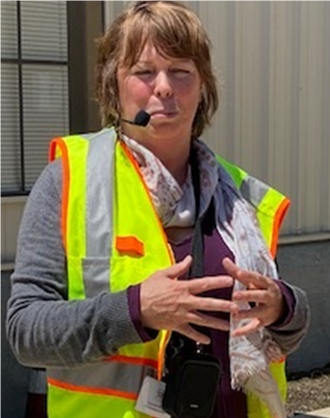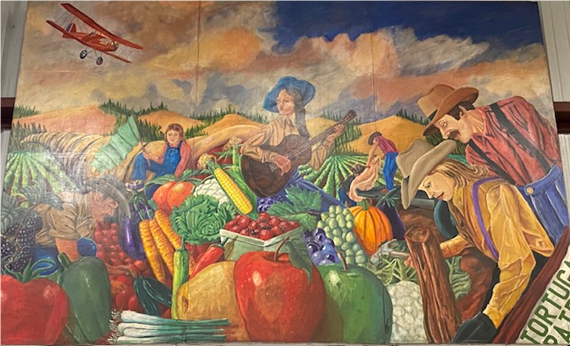
Field Trip to Second Harvest Food Bank
On August 4th, 19 Club members met at the Second Harvest Food Bank in Watsonville. About 8 of us carpooled. In attendance were Co-Presidents Laura Grinder and Kendra Cleary, Co-Presidents Elect Pam Goodman and Lowry Fenton, Michele Bassi, Craig Bagley, Nelson Crandall, Eric Costello, Al De Camara, Win Fernald, Trish Glassy, Dagmar Leguillon, Mardi Padilla, Julie Lambert, Sam Nigh, Anissa Novak, Becky Peters, Kate Southerland, and Matt Wetstein.
We gathered in the front patio, enjoying the pleasant weather and beautiful tile wall. Julie pointed out her family’s tile, but it’s not in the picture

Sandra, Pam, Win, Laura, Craig, Mardi, and Eric.
A sign in sheet was circulating as we arrived. We learned later that as part of its food security protocols, everyone who enters the warehouse must sign in and sign out.
The first announcement was that everyone who had parked on the concrete next door was illegally parked. Five of us immediately scampered off to move our cars.
Chief Development Officer Suzanne Willis, seen below left thinking “Is he really a Rotarian?”, gave us a tour with a nifty headset and belt-worn speaker to ensure everyone could hear. Brand new CEO Erica Padilla-Chavez tagged along to make us feel important.


First stop was the warehouse, piled high with canned goods on palate racks. They didn’t have palate racks in 1989, leaving them a lot to pick up when the shaking stopped.

Left to right, Suzanne, Julie, Laura, Sandra, Lowry, Trish, Win, Michele, Anissa, Craig.

Left to right, Craig, Kate, Trish, Al, Dagmar, Erica, Sam, Sandra, Matt, Suzanne.
The biggest question on everyone’s mind was, “What is lezinine?” but no one had the nerve to ask out loud. Instead, we learned that Second Harvest acts as a distribution hub rather than as a distribution point. Second Harvest provides food to dozens of organizations that distribute food directly to consumers.
From there we moved to a narrow hallway with a 50-year timeline. Who knew that Second Harvest, the nation’s second food bank, was inspired by the Santa Cruz branch of the Black Panthers who were participating the Black Panthers’ nationwide Free Breakfast for School Children Program?
From that narrow hall we moved to the shipping and receiving room and its labor-saving loading docks. Before the loading docks were built, it took half an hour or longer to unload a truck. Now, it takes five minutes.
This painting adorns the wall of the shipping and receiving room, along with a warning from the voice of experience:


From there we passed a capacious freezer with a padded roll-up door that opens and closes in the flash an eye; too fast for the camera to capture. With the door open, everyone with exposed skin below the knees could feel the cold air flowing out of the freezer. Next to it was an equally impressive cooler.
One of our resident vegans, Dagmar, ironically asked if Second Harvest handled meat. Dagmar, why would you want to know? Yes, Second Harvest handles meat. But not normally turkeys. Who has room for multiple frozen turkeys? (Al said that Sam did, but Sam denied it.) Frozen chickens are about as large as people can handle. Most of the meat is canned and comes through the Department of Agriculture.
Next stop was another cooler stocked with strawberries and watermelons, among other things. In answer to questions, we learned that before the pandemic, Second Harvest served around 50,000 persons, roughly 20% of the county’s population. At the height of the pandemic, that figure soared to 100,000 and presently is about 85,000.
We also learned that much of Second Harvest’s offerings includes local fresh fruits and vegetables. Sometimes it is produce that isn’t pretty enough for the retail trade; sometimes it is produce that is too ripe to survive a round trip to a Central Valley distribution center before returns to local shelves.
Food that is not good enough for humans is distributed as animal feed, unless there are too many berries. Animals can stand only so many berries. Food not good enough for animals goes to the composing facility in Seaside.
All the food Second Harvest distributes is given away for free. Well, almost. Sometimes a non-profit needs a food that Second Harvest does not have in stock, such as peanut butter. In that case, Second Harvest will use its buying power to purchase the item at a deeply discounted price with the non-profit contributing a small portion of the purchase price.
After the tour we lunched on deli sandwiches and water in the employee picnic area. The meeting ended promptly on time, with everyone both spiritually and physically sated.


